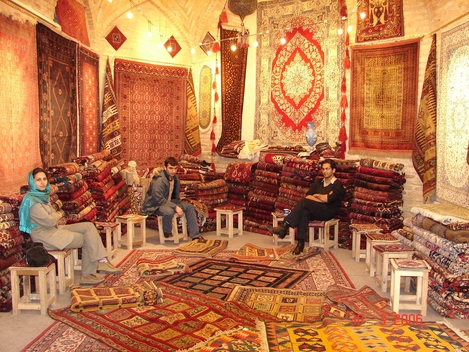 As part of the United States’ withdrawal from the Joint Comprehensive Plan of Action (JCPOA), the US Treasury Department will restore sanctions on a number of key Iranian sectors and activities on August 6.
As part of the United States’ withdrawal from the Joint Comprehensive Plan of Action (JCPOA), the US Treasury Department will restore sanctions on a number of key Iranian sectors and activities on August 6.
Here’s what you need to know about this set of sanctions:
What is the JCPOA?
The JCPOA or Iran nuclear deal is a 159-page document agreed to on July 14, 2015 by the five permanent members of the United Nations Security Council—Britain, China, France, Russia, and the United States—plus Germany with Iran. It traded curbs on Iran’s nuclear program for sanctions relief from the European Union, United States, and United Nations. The JCPOA went into implementation on January 16, 2016.
US President Donald Trump announced on May 8 that the United States would withdraw from the deal—despite Iran’s continued compliance—and re-impose all sanctions lifted under the agreement because of perceived deficiencies in the deal including Iran’s pursuit of “destablizing and malign activities” that the United States and its allies oppose.
What are the Trump administration’s stated goals for a new Iran deal?
President Trump has claimed that the United States is open to a new agreement with Iran. Secretary of State Mike Pompeo on May 21 publicized a twelve-point plan aimed at making Iran a “normal” country by ending its uranium enrichment program, its ballistic missile program, and its support of militant proxies in the Middle East. In return, Pompeo offered a complete lifting of US sanctions and normalized diplomatic and trade relations.
Many observers saw the plan as unrealistic and it was rejected by the Iranian government as a thinly disguised effort at regime change.
What Iran sanctions will snapback on August 6?
According to the US Treasury Department, the following sanctions will be re-imposed:
“Sanctions on the purchase or acquisition of US dollar banknotes by the Government of Iran; sanctions on Iran’s trade in gold or precious metals; sanctions on the direct or indirect sale, supply, or transfer to or from Iran of graphite, raw, or semi-finished metals such as aluminum and steel, coal, and software for integrating industrial processes; sanctions on significant transactions related to the purchase or sale of Iranian rials, or the maintenance of significant funds or accounts outside the territory of Iran denominated in the Iranian rial; sanctions on the purchase, subscription to, or facilitation of the issuance of Iranian sovereign debt; sanctions on Iran’s automotive sector.”
The United States will no longer import Iranian-origin Persian carpets and foodstuffs such as pistachios, and export or re-export commercial airplanes as well as services and parts.
What companies have already left Iran?
The Trump administration gave foreign companies and the foreign subsidiaries of US multinationals ninety days to wind down their business with Iran. In anticipation of the sanctions, over a dozen major companies have already left the country. They include Boeing, General Electric, Maersk, Peugeot, the Reliance refining complex, Siemens, and Total oil and gas. The Trump administration claims that over fifty international entities and firms have committed to leaving Tehran.
What happens if a company doesn’t comply?
The Trump administration has repeatedly said that it “will not hesitate” to penalize US and foreign businesses that don’t comply with re-imposed sanctions on Iran by blocking them from doing business in the United States. In June, US officials from the State Department and Treasury Department met with foreign counterparts in Europe and Asia to explain the new sanctions policy.
What is the European Union doing?
The EU has promised to try to keep the JCPOA alive, despite the accord being in “intensive care.” It has sought to provide channels for trade to continue, but has conceded that it cannot force private businesses to remain in Iran. Several European countries—including Britain, France, and Germany—have also requested “broad exemptions” for their companies. However, the Trump administration has so far rejected these requests.
What has been the impact in Iran?
The Iranian economy, also burdened by corruption and mismanagement, has taken a nosedive since the US withdrawal from the JCPOA. While the Iranian currency has also gone into free fall. The rial is now worth less than 100,000 to the US dollar, although it has recovered slightly from an all-time low of 117,000 rials after President Trump offered to meet his Iranian counterpart without preconditions.
The Iranian people will suffer under the weight of sanctions, while the Iranian government scrambles to find alternatives means to keep the country afloat.
How will Tehran respond?
The Iranian government has shown no indication that it will surrender to the Trump administration’s demands any time soon. The upper echelons of the Iranian government also reacted negatively to Trump’s offer to meet, widely believing that they wouldn’t get anything in return and demanding that the US first return to the JCPOA. However, some Iranians don’t see the harm of President Hassan Rouhani talking to Trump.
Holly Dagres is editor of the Atlantic Council’s IranSource blog, and a nonresident fellow with the Middle East Security Initiative in the Scowcroft Center for Strategy and Security. She also curates The Iranist newsletter. Follow her on Twitter: @hdagres.
Image: A Persian carpet shop in Esfahan's grand bazaar during 2006. (Wikimedia Commons)

